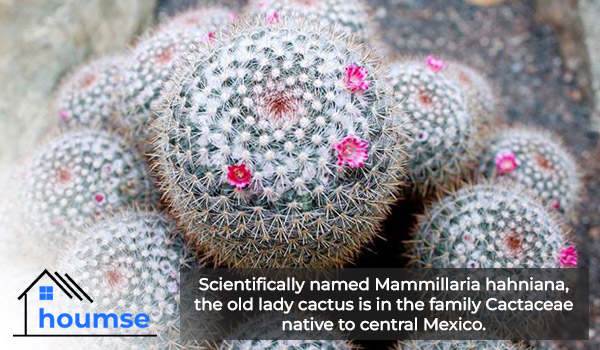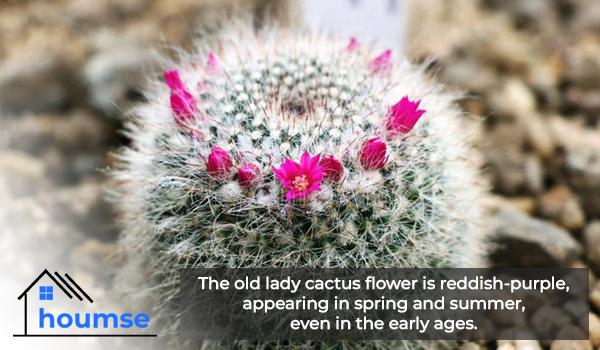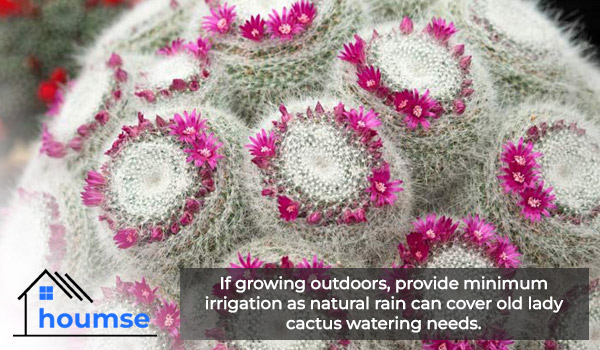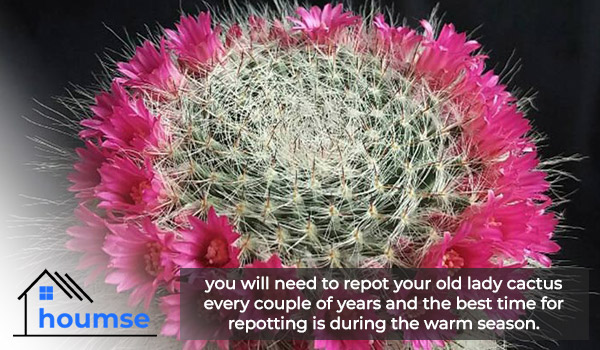Old Lady Cactus Care & Propagation (Mammillaria hahniana)

The old lady cactus is one of the most charming types of hairy cactus. With lovely flowers and silvery hair, the old lady cactus is a must-have for both succulent aficionados and beginner gardeners. Some people like to buy it plant because of its incredible tolerance, and others are interested in the precious old lady cactus flower.
If you are looking for some information about how to grow, maintain and reproduce old lady cactus, its related problems, etc. we have provided all the information here in a comprehensive old lady cactus care guide.
About Old Lady Cactus
Before getting into old lady cactus care and its requirements, you may want to know it better first. Scientifically named Mammillaria hahniana, the old lady cactus is in the family Cactaceae native to central Mexico.
It has solitary or clustered stems covered with dense white bristles (hairs) and fine spines. The official name of old lady cactus is derived from the Latin word “mammilla”, meaning nipple, and referring to the pronounced tubercles in the plants of this genus.
Mammillaria hahniana has a limited range and is listed as a nearly threatened species. Because of deforestation and illegal collection, the old lady cactus population has decreased significantly in recent years.
Old lady Cactus Maintenance
In old lady cactus care, this plant loves the outdoors. However, you can use the tips on how to grow old lady cactus successfully indoors including at homes and offices as well. The good news is that this plant does not contain any toxins neither the spikes nor the tissue which can be dangerous to humans and pets.
How Big Do Old Lady Cactus Grow?
This beautiful plant can grow up to 10 inches in length and up to 20 inches in width. Its stems can grow up to 5 inches in diameter. Therefore, the mammillaria old lady cactus size will not be an issue for those who consider old lady cactus care indoors.
You can find these plants in separate containers, or in terrariums, with other succulents depending on their size, in different shops that have old lady cactus for sale.
Old Lady Cactus Flower
We mentioned that this cactus is a flowering type. The old lady cactus flower is reddish-purple, and is 0.6 inches in diameter. Old lady cactus bloom appears in spring and summer, even in the early ages.
Sometimes old lady cactus flower forms a perfect ring around the stem’s apex, resembling a headband or a tiara. The eye-catching blooms are one of the reasons that the domestic cultivation and old lady cactus care are so popular.
Old Lady Cactus Fruit
The old lady cactus flowers on the plant are followed by fruits. The old lady cactus fruit is actually the seed pod that looks like a red chili pepper. As mentioned above, the red old lady cactus fruit is not toxic. But if you suspect poisoning, contact your local veterinarian or the poison control center immediately.
Old Lady Cactus Seeds
If you already have a Mammillaria hahniana, harvest the old lady cactus seeds from it to use them later for old lady cactus reproduction.
For harvesting, wait until the old lady cactus fruit (seed pot) becomes so loose that they almost fall off with a gentle move. Then you can harvest the old lady cactus seeds inside and grow them using this old lady cactus care guide.

Old Lady Cactus Care
The easy old lady cactus care has made it widely popular. This impressive cactus thrives in dry, hot conditions with very little water. This slow-growing plant loves the outdoors where it can enjoy sunlight freely, but you can also grow it inside.
Below, you’ll find important old lady cactus care tips.
Light
If growing indoors, we suggest choosing the brightest location in your house to place it there. A south-facing window is an excellent spot for this plant to get 4 to 6 hours of sunlight. Window spots are the sunniest spots in a house and help the growth of your Mammillaria old lady cactus. If you can provide such a location, use a grow light.
If growing outdoors, do not put the plant in a heavily shaded spot at all. But this does not mean that the Mammillaria hahniana needs full sun exposure all day long. Interestingly, although this genus loves the sun, it does not thrive very well under very intense sunlight for a long time. During the hottest time of the day, bright and partial shade is best for old lady cactus care.
Tip: During heat waves or intense heat, old lady cactus may suffer from sun damage. To prevent this, move the plant to a shadier location during heat waves.
Water
If growing outdoors, provide minimum irrigation in old lady cactus care as natural rain can cover the water requirements. If not, water it once a week during warmer months, and once a month during cooler months. As pointed out, it is best to reduce watering during winter. You should keep the soil quite dry during the winter months to encourage flowering.
If growing indoors, you do not need to water Mammillaria old lady cactus as frequently as outdoor plants, especially if it is not exposed to a lot of sunlight. Before watering your plant, make sure that the soil mix is dry. If dry, water the plant thoroughly and do not water again until the top inch of soil has completely dried out.
Tip: Empty the plate of any excess water that drains out of the pot immediately so that the plant does not sit in water and rot. In addition, avoid misting the cactus. If you need further help with how often to water old lady cactus, use a moisture meter for detecting the soil’s moisture level.

Soil
In old lady cactus care, providing a well-draining, porous soil is necessary for growing it outdoors or indoors. You can use a standard cactus mix combined with perlite (1:1) for extra drainage. You can also use a sandy mixture of coarse sand and cactus mix (1:1), or a combination of these three (1:1:1) to have a porous soil mixture.
Also, it is better to choose a pot with sufficient drainage holes for your plant. A pot like this lets the excess water flow out of the pot.
Fertilizer
Mammillaria old lady cactus thrives in soil with high potassium. So, it is a good idea to consider fertilizing in old lady cactus care. Feed your plant with a potassium fertilizer, at least once in the summer months.
Diseases
Fungal infection is one of the old lady cactus problems that you might notice. To make sure that your plant does not get a fungal infection, add a natural net on top of the drainage layer. Dried fibers such as dried moss is a suitable option. Next, sprinkle it with activated charcoal before adding the potting soil.
Old Lady Cactus Repotting
In old lady cactus care indoors, you will need to repot it every couple of years. Before starting the old lady cactus repotting, make sure the soil is dry. This is because the dry soil makes it easier to remove the plant from the pot. Next, knock the old soil from the roots away to remove any rotted or dead roots in the process.
After old lady cactus repotting, leave the soil dry for a week before watering so the plant can heal and recover from the shock of repotting. After a few days, water it thoroughly, and do not water it again until the soil is dry.
Tip: The best time for repotting the old lady cactus is during the warm season.

Old Lady Cactus Problems
This plant needs special care, but it is not difficult. Paying attention to the old lady cactus care tips above will help you avoid all old lady cactus problems. However, one of the unpleasant old lady cactus problems (if you can call it a problem), is the lack of old lady cactus flower. If your Mammillaria hahniana is not blooming as you expected, there are some methods to solve it.
We mentioned that this striking plant is one of the few cacti that flower even before maturity. You should note that not all cactuses are ready to bloom, and some may not bloom at all, as there are many environmental factors that we cannot control in old lady cactus care.
What helps us to prevent old lady cactus problems from blooming, is the cold weather of winter. You should also decrease the watering in winter to avoid deterring the old lady cactus flower growth. If the Mammillaria old lady cactus remains damp or sits in water for too long, it will fail to flower completely.
Pro Tip to Encourage Old Lady Cactus Bloom
In addition to reducing the irrigation to the minimum during cold seasons and allowing the Mammillaria hahniana to be kind of dormant, you can boost old lady cactus bloom in the spring and summer.
To do this, increase the irrigation steadily and fertilize your cactus. We recommend applying fertilizers at a quarter or half strength, about every two weeks during the growing season in old lady cactus care. A balanced blend of fertilizer or a special fertilizer for cacti and succulents diluted to half strength are both good choices. Blooming can start from late winter and go well into spring and summer.

Old Lady Cactus Propagation
There are different methods for old lady cactus reproduction such as cactus grafting, division, and cuttings. But offsets and old lady cactus seeds are your best choice, due to the physiology of this plant.
You can successfully reproduce this succulent using the old lady cactus seeds growing in clusters that form around the mature plant’s base. After harvesting the offsets using protective gloves, here are the steps on how to grow old lady cactus:
- Let the seeds dry out on some dry tissue or in a dry location. Depending on the environment’s humidity level, you may need to wait a few days for the offsets to dry.
- Where you cut off the offset from the plant. As an optional step, place some rooting hormone on it.
- Then, prepare a small container or a pot with a fast-draining cactus growing mix. You can find this type of soil almost anywhere.
- When the old lady cactus seeds have dried, plant the callused side in the potting soil.
- Place the pot in a bright location, away from direct sunlight. When the soil mix feels dry, water the seeds every week.
Old lady cactus propagation is convenient like its care. Just remember that you need to wait for a few weeks so that the plant establishes itself. After that, you can place it in direct sunlight or plant it outdoors.
- In this post:
- About Old Lady Cactus
- Old Lady Cactus Care
- Old Lady Cactus Repotting
- Old Lady Cactus Problems
- Old Lady Cactus Propagation



